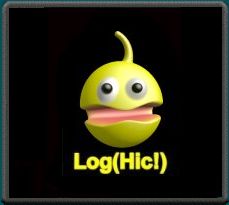Retro Replay Review
Gameplay
Log(Hic!) offers a deceptively simple puzzle mechanic that quickly reveals unexpected depth. Smiley faces of varying colours rain down at a steady pace, and your objective is to stack them into vertical trios of the same hue. Unlike many block-dropping games, however, Log(Hic!) introduces a physics twist: pieces will slide off one another if you don’t build a stable foundation. This slip-and-slide behavior forces you to think two steps ahead, planning not only colour matches but also support structures to keep your stacks from toppling.
You start with only two colours, which makes the opening levels feel manageable and inviting. As you progress, new colours are introduced one by one, ratcheting up the challenge. What might begin as a casual matching exercise soon becomes a delicate balancing act. You’ll find yourself creating angled support ledges, overhangs, and complex scaffolding just to align three matching faces vertically. It’s a puzzle experience that rewards patience and creativity—and punishes hasty placements.
The game’s pace is deliberately measured, allowing you the time to assess the board and experiment with different building strategies. Yet despite that relaxed tempo, the threat of an ever-growing tower keeps tension high: one miscalculated slip and your carefully stacked faces can tumble to the bottom, potentially leaving you scrambling. This balance of calm planning and sudden crisis lends every session a satisfying ebb and flow.
Log(Hic!) also features quick rounds that are perfect for short play sessions. You never feel locked into a marathon, and every restart is an opportunity to refine your approach. Whether you’re aiming for a new personal best or simply enjoying the tactile pleasure of balancing digital smileys, the gameplay loop remains fresh and engaging throughout.
Graphics
Visually, Log(Hic!) opts for a clean, minimalist aesthetic that complements its straightforward puzzle design. The smiley faces are rendered with bright, solid colours that stand out crisp and clear against a neutral background. This colour-coding is essential to gameplay, helping you instantly identify which pieces can form a match and which will add complexity to your budding structure.
Animation is smooth and fluid: when a new face descends, it arcs gracefully into place, and when a mismatched block slips off your stack, there’s a satisfying bounce that underscores the game’s physics focus. These subtle motion details make every placement feel weighty and important, heightening the tactile sense of stacking blocks—despite being purely digital.
There are no flashy particle effects or 3D models here—Log(Hic!) doesn’t need them. Instead, the developers keep the screen uncluttered, allowing you to concentrate fully on puzzle-solving. Simple UI elements display your current level, the next incoming face, and your accumulated score without ever drawing attention away from the playfield.
Overall, the graphical presentation is purpose-driven: it’s all about clarity and responsiveness. In a genre where split-second colour recognition and precise block positioning matter, Log(Hic!) nails the balance between aesthetic simplicity and functional design.
Story
Log(Hic!) does not lean on narrative storytelling; instead, it places you directly into its core puzzle challenge without any framing plot. For players seeking an elaborate backstory or character development, this title may feel sparse. There’s no cast of heroes to root for or villains to outwit—your only adversaries are the incoming smiley faces and the ticking timer of stacking pressure.
However, what Log(Hic!) lacks in traditional story it makes up for with emergent drama. Each game session unfolds like a miniature saga of triumph and collapse, where a single misplaced face can trigger a cascading failure or a stunning comeback. You become the protagonist by default, as every strategic choice and recovery from near-disaster adds narrative weight to your playthrough.
Progression comes in the form of escalating difficulty rather than cutscenes or text logs. Unlocking new colours serves as a form of milestone, offering a tangible sense of advancement and fresh puzzles to solve. The increasing palette ensures that each level feels like a distinct chapter in your ongoing battle for balance and matching mastery.
For those who prize storyless, gameplay-first experiences, Log(Hic!) delivers a pure, unadulterated puzzle environment. The “plot,” such as it is, is written in the dynamic shapes and shifting towers you create with every round.
Overall Experience
Log(Hic!) shines as an accessible yet challenging puzzle game that is easy to pick up but hard to master. Its core mechanic—the interplay of colour matching and physical stability—offers a refreshing twist on the match-three formula. Each session feels purposeful, whether you’re experimenting with creative supports or racing to clear colours before the stack reaches the top.
The game’s learning curve is gently sloped at first, but as more colours enter the mix, you’ll need to summon sharper spatial reasoning and forward planning. This gradual ramp-up keeps frustration at bay while continually rewarding skill development. Casual gamers will appreciate the short, satisfying rounds, while completionists can strive for longer survival times and higher colour-count combinations.
Though the absence of a narrative might deter story-driven players, it also means that nothing distracts from the pure puzzle experience. The minimalist visuals, fluid animations, and intuitive controls come together to create a polished and focused title. Whether you have five minutes on your commute or an hour of free time at home, Log(Hic!) adapts seamlessly to your schedule.
In summary, Log(Hic!) is a tidy, engaging package for anyone who loves strategic stacking puzzles. It may not reinvent the wheel, but its clever twist on gravity and matching mechanics ensures that every playthrough feels fresh, challenging, and surprisingly addictive.
 Retro Replay Retro Replay gaming reviews, news, emulation, geek stuff and more!
Retro Replay Retro Replay gaming reviews, news, emulation, geek stuff and more!








Reviews
There are no reviews yet.